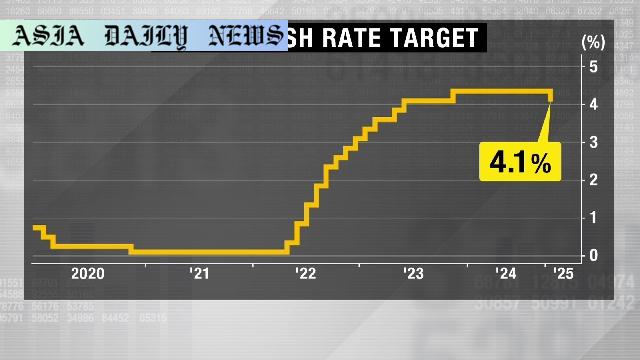Interest Rate: The Reserve Bank of Australia cuts its key interest rate for the first time since 2020 amidst easing inflation.
The Reserve Bank of Australia reduces the cash rate target to 4.1%.
This is the first interest rate cut since November 2020.
Consumer price inflation now within the RBA’s target of 2–3%.
The bank warns that inflation risks remain and will monitor the economy.

Introduction: A Decisive Monetary Decision
The Reserve Bank of Australia (RBA) has taken a decisive step in its monetary policy, announcing its first interest rate cut since November 2020. With inflationary pressures easing, the central bank reduced its target cash rate by 0.25 percentage points, bringing it to 4.1%. This marks a significant moment following a series of 13 rate hikes since 2022, as the RBA had previously acted aggressively to control soaring inflation post-pandemic.
Why the Rate Cut Now?
The RBA’s decision comes against the backdrop of easing inflation rates. The Consumer Price Index (CPI) for the October-December period rose by 2.4% compared to the previous year, which falls comfortably within the RBA’s target inflation range of 2–3%. This suggests that the central bank’s previous actions have had the desired effect of curbing inflation while cooling off economic activity. Governor Michele Bullock acknowledged the impact of the rate hikes, stating that higher interest rates successfully restrained economic activity and helped bring inflation under control.
The Economic Climate That Prompted the Shift
Over the past two years, the RBA’s aggressive approach to interest rate hikes was deemed essential to battle surging inflation, which had spiked significantly during the global wave of post-pandemic recovery. Massive disruptions in global supply chains, rising energy costs, and a tightening labor market contributed to the economic landscape. However, recent data has shown signs of stabilization, with inflation entering manageable levels. Still, the RBA remains cautious, indicating that further risks from global markets, such as US tariffs, could impact Australia’s economy.
Implications for Australian Households
The impact of the interest rate cut is likely to resonate across Australian households and businesses. For homeowners with mortgages, the reduction could mean some respite as monthly repayments ease slightly. Businesses, especially small to medium enterprises relying on credit, may also find it easier to borrow, allowing for further growth and investment. However, the cut is not without risks. Critics argue that reducing rates too soon could undermine progress in curbing inflation, particularly if external factors like rising commodity prices or global economic instability come into play.
A Global Context
Australia’s decision to lower interest rates starkly contrasts with many of its global peers. Central banks in the US, Europe, and parts of Asia have maintained or further tightened their monetary policies in 2023 to combat persistent high inflation. Michele Bullock noted the importance of monitoring external influences, including ongoing global uncertainties and trade tensions. Notably, she highlighted the economic ripple effects of actions like US President Donald Trump’s planned tariffs, which remain an important variable as they could affect Australian exports or lead to broader trade distortions.
Looking Ahead: What’s Next for Monetary Policy?
While the RBA has taken the first steps toward loosening monetary policy, it remains cautiously optimistic. Governor Bullock emphasized that the board is not yet prepared to declare victory over inflation. Instead, she underscored the need for a balanced approach to monetary management, underscoring the importance of continued vigilance. Future decisions will be data-dependent and influenced by evolving economic conditions, both domestic and international.
Conclusion: A Significant Policy Shift
The RBA’s first rate cut in three years marks an important turning point in Australia’s economic recovery journey. While the decision brings hope to many businesses and households, it also underscores the delicate balancing act that central banks face in maintaining price stability while fostering sustainable economic growth. In the coming months, all eyes will remain on the RBA’s next moves as economic data continues to shape the nation’s monetary policy landscape.
Commentary
Context and Timeliness
Australia taking its first step toward reducing interest rates since 2020 is indeed a bold and timely decision. With inflation back within the desired 2–3% range, this move signals a turning point for the country’s post-pandemic recovery. However, the decision has sparked debates about whether this relaxation of monetary policy comes too soon. Given the uncertainty in global markets, including potential US tariffs, the timing of the RBA’s rate cut reflects an optimistic yet cautiously calculated step forward.
The Balancing Act
The Reserve Bank of Australia faces the challenging dual responsibility of maintaining inflation under control while ensuring that economic activity does not stagnate. It’s clear that the 13 consecutive rate hikes effectively cooled off inflation, albeit at the expense of some economic momentum. The rate cut now offers some breathing room, particularly for mortgage holders and small businesses, but it remains to be seen whether this will tip the scales too far in the opposite direction. Striking this balance is critical in a world still grappling with the aftershocks of global disruptions.
A Broader Perspective
Australia’s interest rate decision is significant when viewed in context with global trends. Many central banks are still focused on inflation containment, maintaining or even increasing interest rates. The RBA’s decision might be an indication of what’s to come for other nations if economic conditions improve. However, it also serves as a reminder of every country’s unique circumstances and the need for tailored monetary policies.
Conclusion
Overall, the Reserve Bank of Australia’s decision to cut rates marks a pivotal moment in its economic strategy. It’s a sign of progress and optimism but should be approached with caution. While it undoubtedly provides relief for many Australians, future data will determine if this was the right move at the right time. For now, it serves as a case study in flexible and adaptable monetary policy amid a changing global economic landscape.


